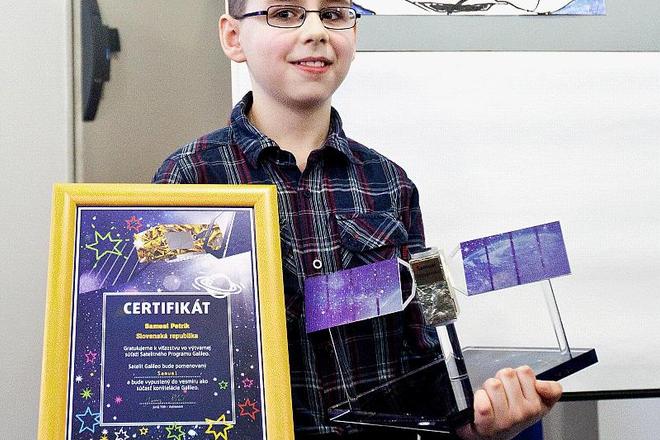ONE OF the satellites that will be part of the European navigation system called Galileo will be named Samuel, as a drawing done by 10-year-old Samuel Petrík from Partizánske was chosen in the Slovak round of the European Space and Astronautics competition from among 764 entries by Slovak children. The jury consisted of Slovak host Adela Banášová, Slovak astronomer Juraj Tóth and the press secretary the European Commission in Slovakia, Ingrid Ludviková. Petrík’s drawing titled My Satellite Galileo featured a Slovak astronaut and the young boy’s own conception of cosmic space. The jury said the winning drawing attracted its attention through its colourfulness, positivity, artistic perception and overall impression.
“Samuel’s picture has the bonus of eye contact with the author himself, who launched himself into space in this way, not forgetting also the need to feel national pride in the form of a Slovak symbol,” Banášová said in summing up her opinion of the winning entry. Juraj Tóth praised the motif chosen by the winner to the SITA newswire: “Apart from space objects, space shuttles and satellites, he also drew the Slovak astronaut of the future – who has a child’s face. For me, it has symbolised that our children will be able to directly take part in space research – which is already partially true through the Galileo programme.”
The artistic competition was organised by the European Commission and children between the ages of 9 and 11 were able to enter an artwork between September 1 and November 15 last year. The children were allowed to use material of their choice as well as any drawing, painting or colouring technique. The young student, apart from having the honour of a satellite named after him, received several other valuable prizes and – as Banášová pointed out – could skip one day at school.
The first two satellites of the Galileo system were launched into space on October 21, 2011 and were named after winners from Bulgaria and Belgium: Natalia and Thijs. Two more satellites will follow this year, with more to come later. The names of some of the future satellites are already known: Anastasia (Greek), Tijmen (Dutch), Tara (Slovenian) and Milena (Estonian).
The Galileo system enables users to determine a precise location like the Global Positioning System (GPS) does but with greater accuracy and reliability and it will be independent but compatible with the US-based GPS system and with the Russian Glonass system, SITA wrote. In 2014 Galileo will consist of at least 27 satellites orbiting at about 23,000 kilometres above the earth’s surface initially offering three services: an Open Service without charge; a Publicly Regulated Service that is available to police or rescue service in emergency situations; and a Rescue-Search Service for emergencies at sea. Services of a more commercial character are expected to follow later.



 Samuel Petrík with his winning drawing. (source: SITA)
Samuel Petrík with his winning drawing. (source: SITA)